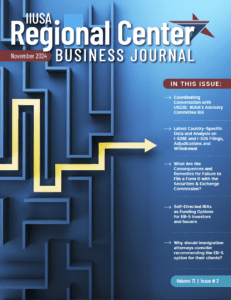RCBJ Perspectives: “New TEA Rules – Frequently Asked Questions”
Originally Published in the April 2020 Regional Center Business Journal
By Alex Brown | Senior Economist, Impact DataSource
EB-5 Immigrant Investor Program Modernization, the final rule published by the Department of Homeland  Security (DHS) in the Federal Register on July 24, 2019 (“Final Rule”), went into effect on November 21, 2019. Under the Final Rule, USCIS is no longer accepting Targeted Employment Area (“TEA”) certifications from the individual states. Instead, USCIS is requiring that I-526 petitions contain evidence that a project qualifies as a TEA and will review that evidence as part of I-526 adjudication.
Security (DHS) in the Federal Register on July 24, 2019 (“Final Rule”), went into effect on November 21, 2019. Under the Final Rule, USCIS is no longer accepting Targeted Employment Area (“TEA”) certifications from the individual states. Instead, USCIS is requiring that I-526 petitions contain evidence that a project qualifies as a TEA and will review that evidence as part of I-526 adjudication.
Additionally, the Final Rule changed the requirements for qualification as a high-unemployment TEA. MSAs, counties, cities with a population greater than 20,000 and outside of an MSA, and census tracts can all qualify individually if their unemployment rate is at least 150% of the national unemployment rate. A high-unemployment TEA may also consist of a combination of “directly adjacent” tracts, if the weighted average unemployment rate of the combined tracts is at least 150% of the national unemployment rate.
Q: Since USCIS is no longer recognizing TEA letters provided by the states, how do I obtain a TEA certification?
A: Under the Final Rule, evidence that a Project site qualifies as a TEA must be submitted with each investor’s I-526 petition and will be reviewed by USCIS as part of I-526 adjudication. USCIS will not be providing a separate process for reviewing TEA certifications. Under the Final Rule, TEA status will not be confirmed until the I-526 petition has been processed, and as of March 18, 2020, I-526 processing time is currently estimated to be between 33 and 50 months.
Q: What evidence needs to be presented to USCIS to show that a Project site qualifies as a TEA?
A: The evidence submitted to USCIS as part of the I-526 petition must show that at the time of investment or I-526 filing, whichever came first, the Project site met the requirements for TEA qualification. The evidence should include the source of the data used to determine the labor statistics of the MSA, county, city, or census tract(s), the TEA unemployment threshold, a map showing the project site and the county, city, or census tract(s) included in the TEA, the labor statistics (civilian labor force, employment, and unemployment, plus the unemployment rate) of the county, city, or census tract(s), and the weighted average unemployment rate of the combined census tracts if the TEA relies on census tract combination.
Q: How many tracts can I combine to create a TEA?
A: USCIS does not have a specific limit on the number of tracts that can be combined, but the combination is limited to the project tract(s) and any or all “directly adjacent” tracts.
CONTINUE READING








